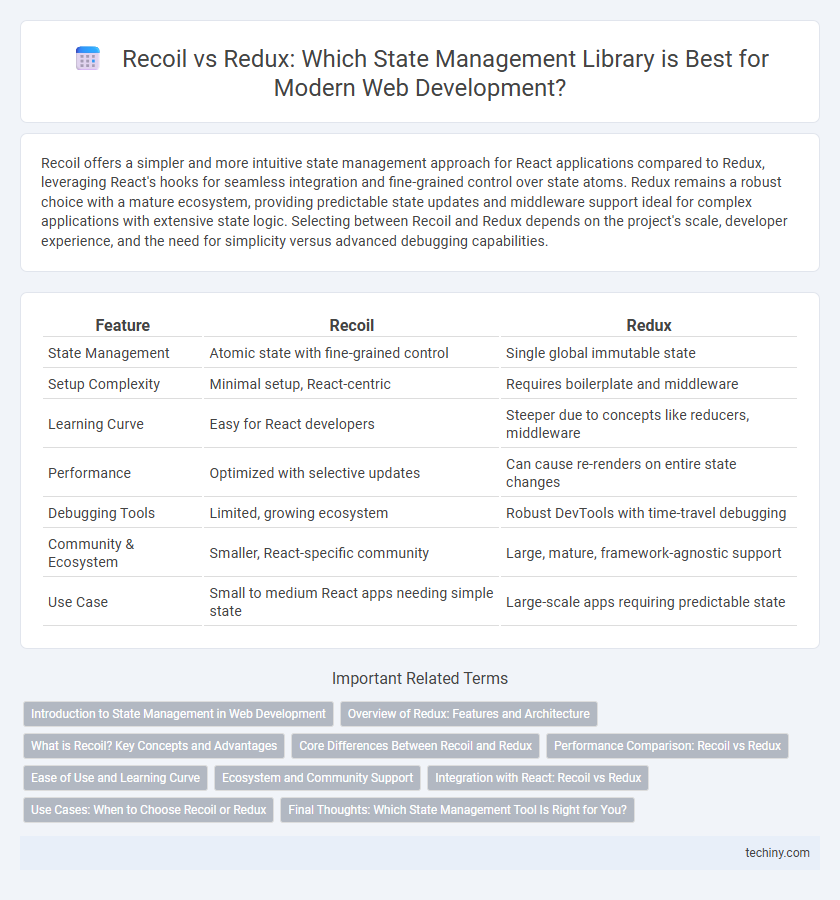Recoil offers a simpler and more intuitive state management approach for React applications compared to Redux, leveraging React's hooks for seamless integration and fine-grained control over state atoms. Redux remains a robust choice with a mature ecosystem, providing predictable state updates and middleware support ideal for complex applications with extensive state logic. Selecting between Recoil and Redux depends on the project's scale, developer experience, and the need for simplicity versus advanced debugging capabilities.
Table of Comparison
| Feature | Recoil | Redux |
|---|---|---|
| State Management | Atomic state with fine-grained control | Single global immutable state |
| Setup Complexity | Minimal setup, React-centric | Requires boilerplate and middleware |
| Learning Curve | Easy for React developers | Steeper due to concepts like reducers, middleware |
| Performance | Optimized with selective updates | Can cause re-renders on entire state changes |
| Debugging Tools | Limited, growing ecosystem | Robust DevTools with time-travel debugging |
| Community & Ecosystem | Smaller, React-specific community | Large, mature, framework-agnostic support |
| Use Case | Small to medium React apps needing simple state | Large-scale apps requiring predictable state |
Introduction to State Management in Web Development
State management in web development involves handling the dynamic data that influences user interfaces, improving application scalability and maintainability. Recoil offers a modern, minimalistic approach to state management with fine-grained atomic updates and seamless React integration. Redux provides a predictable state container using a unidirectional data flow and centralized store, ensuring consistent state changes through strict action dispatching.
Overview of Redux: Features and Architecture
Redux is a predictable state container for JavaScript apps, featuring a single immutable state tree that ensures consistent state management. It uses pure reducer functions to handle state transitions and employs middleware like Redux Thunk and Redux Saga for managing asynchronous operations. The architecture's unidirectional data flow simplifies debugging and enhances scalability in complex web development projects.
What is Recoil? Key Concepts and Advantages
Recoil is a state management library for React that enables efficient and scalable state sharing across components with minimal boilerplate. Key concepts include atoms, which represent shared state units, and selectors, which derive computed state for optimized re-rendering. Advantages of Recoil include fine-grained state updates, seamless integration with React's concurrent mode, and improved developer experience through simple and intuitive APIs.
Core Differences Between Recoil and Redux
Recoil offers a more flexible and minimalistic approach to state management in React applications by utilizing atoms and selectors for fine-grained state control, whereas Redux relies on a centralized store and reducers to manage state immutably. Recoil's asynchronous state queries and built-in support for derived state simplify handling complex state dependencies compared to Redux's middleware-driven side effect management with tools like Redux Thunk or Saga. Performance-wise, Recoil enables more efficient component re-rendering through its subscription model, while Redux often results in broader state updates requiring manual optimization techniques.
Performance Comparison: Recoil vs Redux
Recoil offers superior performance in web development by using fine-grained atom-based state management, which minimizes unnecessary component re-renders compared to Redux's global store approach. Redux relies on a single immutable state tree, often causing larger component trees to re-render even when only small parts of the state change, impacting application responsiveness. Benchmark tests indicate Recoil's selective subscription model significantly reduces rendering overhead, enhancing user experience in complex React applications.
Ease of Use and Learning Curve
Recoil offers a simpler API and more intuitive state management model, making it easier for beginners to grasp compared to Redux's more complex boilerplate and strict architectural patterns. The learning curve for Recoil is generally shorter, as it integrates directly with React hooks and requires less setup. Redux demands a deeper understanding of concepts like reducers, actions, and middleware, which can slow down initial development for new users.
Ecosystem and Community Support
Recoil offers a modern, React-centric state management solution with a rapidly growing ecosystem that includes seamless integration with React's concurrent features, while Redux benefits from a mature, extensive ecosystem supported by decades of community contributions, middleware, and developer tools. Redux's vast community provides robust support, extensive documentation, and a wide array of third-party libraries, ensuring reliability and scalability for complex applications. Recoil's ecosystem is evolving quickly, favored for its simplicity and native React compatibility, attracting developers looking for lightweight state management solutions.
Integration with React: Recoil vs Redux
Recoil offers seamless integration with React through its native hooks like useRecoilState and useRecoilValue, enabling fine-grained state management directly within React components. Redux requires additional setup using react-redux bindings, such as the useSelector and useDispatch hooks, to connect the Redux store with React components. Recoil's design prioritizes React concurrency features, facilitating optimized rendering performance compared to Redux's more centralized and boilerplate-heavy approach.
Use Cases: When to Choose Recoil or Redux
Recoil excels in applications requiring fine-grained state management with minimal boilerplate, such as real-time collaboration tools and dynamic forms, benefiting from its seamless React integration and atom-based state structure. Redux is better suited for large-scale applications with complex state logic and middleware needs, especially those demanding time-travel debugging, centralized state management, and predictable state transitions. Choosing Recoil or Redux depends on project complexity, scalability requirements, and the development team's familiarity with each library's patterns and ecosystem.
Final Thoughts: Which State Management Tool Is Right for You?
Recoil offers a simpler, more flexible state management solution that integrates seamlessly with React's concurrent features, making it ideal for complex, modern applications requiring fine-grained state updates. Redux provides a robust, predictable state container with extensive middleware and developer tooling, best suited for large-scale projects with strict state management needs and a large development team. Choosing between Recoil and Redux depends on your application's complexity, team expertise, and preference for immutability versus direct state manipulation.
Recoil vs Redux Infographic

 techiny.com
techiny.com